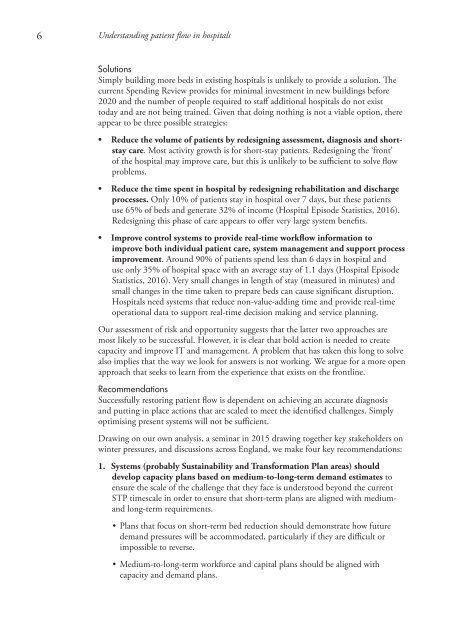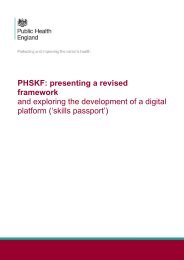Understanding patient flow in hospitals
understanding_patient_flow_in_hospitals_web_0
understanding_patient_flow_in_hospitals_web_0
Create successful ePaper yourself
Turn your PDF publications into a flip-book with our unique Google optimized e-Paper software.
6 <strong>Understand<strong>in</strong>g</strong> <strong>patient</strong> <strong>flow</strong> <strong>in</strong> <strong>hospitals</strong><br />
Solutions<br />
Simply build<strong>in</strong>g more beds <strong>in</strong> exist<strong>in</strong>g <strong>hospitals</strong> is unlikely to provide a solution. The<br />
current Spend<strong>in</strong>g Review provides for m<strong>in</strong>imal <strong>in</strong>vestment <strong>in</strong> new build<strong>in</strong>gs before<br />
2020 and the number of people required to staff additional <strong>hospitals</strong> do not exist<br />
today and are not be<strong>in</strong>g tra<strong>in</strong>ed. Given that do<strong>in</strong>g noth<strong>in</strong>g is not a viable option, there<br />
appear to be three possible strategies:<br />
• Reduce the volume of <strong>patient</strong>s by redesign<strong>in</strong>g assessment, diagnosis and shortstay<br />
care. Most activity growth is for short-stay <strong>patient</strong>s. Redesign<strong>in</strong>g the ‘front’<br />
of the hospital may improve care, but this is unlikely to be sufficient to solve <strong>flow</strong><br />
problems.<br />
• Reduce the time spent <strong>in</strong> hospital by redesign<strong>in</strong>g rehabilitation and discharge<br />
processes. Only 10% of <strong>patient</strong>s stay <strong>in</strong> hospital over 7 days, but these <strong>patient</strong>s<br />
use 65% of beds and generate 32% of <strong>in</strong>come (Hospital Episode Statistics, 2016).<br />
Redesign<strong>in</strong>g this phase of care appears to offer very large system benefits.<br />
• Improve control systems to provide real-time work<strong>flow</strong> <strong>in</strong>formation to<br />
improve both <strong>in</strong>dividual <strong>patient</strong> care, system management and support process<br />
improvement. Around 90% of <strong>patient</strong>s spend less than 6 days <strong>in</strong> hospital and<br />
use only 35% of hospital space with an average stay of 1.1 days (Hospital Episode<br />
Statistics, 2016). Very small changes <strong>in</strong> length of stay (measured <strong>in</strong> m<strong>in</strong>utes) and<br />
small changes <strong>in</strong> the time taken to prepare beds can cause significant disruption.<br />
Hospitals need systems that reduce non-value-add<strong>in</strong>g time and provide real-time<br />
operational data to support real-time decision mak<strong>in</strong>g and service plann<strong>in</strong>g.<br />
Our assessment of risk and opportunity suggests that the latter two approaches are<br />
most likely to be successful. However, it is clear that bold action is needed to create<br />
capacity and improve IT and management. A problem that has taken this long to solve<br />
also implies that the way we look for answers is not work<strong>in</strong>g. We argue for a more open<br />
approach that seeks to learn from the experience that exists on the frontl<strong>in</strong>e.<br />
Recommendations<br />
Successfully restor<strong>in</strong>g <strong>patient</strong> <strong>flow</strong> is dependent on achiev<strong>in</strong>g an accurate diagnosis<br />
and putt<strong>in</strong>g <strong>in</strong> place actions that are scaled to meet the identified challenges. Simply<br />
optimis<strong>in</strong>g present systems will not be sufficient.<br />
Draw<strong>in</strong>g on our own analysis, a sem<strong>in</strong>ar <strong>in</strong> 2015 draw<strong>in</strong>g together key stakeholders on<br />
w<strong>in</strong>ter pressures, and discussions across England, we make four key recommendations:<br />
1. Systems (probably Susta<strong>in</strong>ability and Transformation Plan areas) should<br />
develop capacity plans based on medium-to-long-term demand estimates to<br />
ensure the scale of the challenge that they face is understood beyond the current<br />
STP timescale <strong>in</strong> order to ensure that short-term plans are aligned with mediumand<br />
long-term requirements.<br />
• Plans that focus on short-term bed reduction should demonstrate how future<br />
demand pressures will be accommodated, particularly if they are difficult or<br />
impossible to reverse.<br />
• Medium-to-long-term workforce and capital plans should be aligned with<br />
capacity and demand plans.



